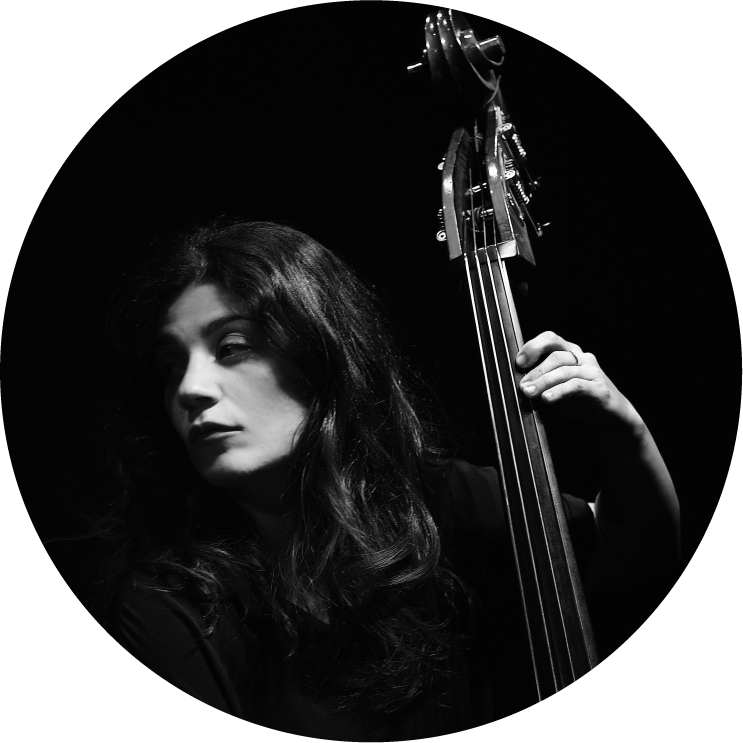The music of Ilaria Capalbo does not merely unfold. It breathes, pulses, and remembers. Listening to the Italian composer and bass player feels like being in the narration of a story. Her instruments — double bass and electric bass — do not stand apart from her: they are vessels for something elemental. Far from the trope of the jazz virtuoso or any contemporary jazz trend, her music stands alone in its ground-shifting intensity and profound emotional impact.
Known for moving seamlessly across genres, Capalbo has nevertheless maintained a relationship with tradition and the influences who have shaped her practice. She incorporates elements from classical orchestration, modern jazz arranging, free improvisation and rock music in her composition process, using often unconventional techniques to build bridges between extremely different sonic landscapes.
Crafted from the point of view of the bass and its role in an ensemble, Capalbo’s music is rooted in the relationship between body and instrument and in the impact of this synergy in the creative process both on and off-stage. The music is thought to rely on every musician in the ensemble as an unique, equally important voice. With a predilection for larger bands and multi-section ensembles, it is no wonder that Capalbo’s sparse use of electronics/effects is not merely aesthetic but it harnesses and envelops their power in an already complex sound palette. Lira has defined her playing as “strong, visionary, architectonic” and All About Jazz has praised her music as “a delight [which] bolsters the faith in the future of jazz”.
Capalbo’s debut album Karthago (2022), composed during the pandemic, laid the foundation for her practice of methodical, journal-like composition. A meditation on loss and reconstruction, the album’s sonic architecture is built on the interaction of two, five or seven musicians. Like in the emphatic opening track, Belóved, where the urgency of love is displayed through chiseled lines for brass and woodwinds. Or in the title track Karthago, where the listeners assist to the cataclysmic unfolding of fate. Audience and critic alike responded enthusiastically to the album’s layered complexity and the music has since been performed on some of Europe’s most prestigious venues and festivals, lastly appearing in the official selection for the European Showcases at jazzahead! in April 2025 where it was performed for a full-seated Schlachthof. Capalbo has continued to forge a distinct path through the vast possibilities of contemporary jazz, steadily collaborating with artists from the world of classical music, pop, and avant-garde, while always retaining her unmistakable sound.
Capalbo resists the linear path. Her practice, informed by an education in double bass and composition at the Conservatory of Salerno, Italy and Stockholm’s Kungliga Musikhögskolan, as well as a degree in Visual Arts from Accademia di Belle Arti in Napoli, relies on live performance as means of compositional development, as if it were a “living organism.” With further studies in Sound Art at Stockholm’s prestigious arts university Konstfack she weaves a synesthetic language that pushes the boundaries between disciplines.
Capalbo’s music moves through extremes — from silence to saturation, from minimalist textures to near-orchestral density. It is less a showcase of virtuosity than a vessel for a deeper message. Sound and form, in her world, are sculpted until they becomes something else entirely: a kind of presence, alive with tension and release and the possibility of becoming. Although a reference to her influences is evident in her production, Capalbo’s music seem to address the larger question of what it means to engage in the act of creation as a woman, mother, musician in this day and age. Her work is far from autobiographical. It is devotional.
Her composition resume extends to contemporary dance, film and theatre. A steady collaborator of renown Swedish contemporary dance company Cullberg and choreographer Freddy Houndekindo, she has premiered commissioned work at multidisciplinary festivals such as EarEye Festival in Malmö and Explorations of Now in Stockholm.
In 2025 she completed the recording of her second album entitled The Brightest Sun — a work that originates from the radical reorientation of new motherhood. If Karthago was shaped by ashes, the new chapter is shaped by water: fluid, luminous and tidal.
ph: Klaudia A. Rychlyk

